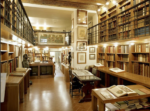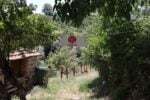Anush Hamzehian & Vittorio Mortarotti – Eden
.jpg)
Questo lavoro si chiama Eden, come il giardino da cui l’uomo fu cacciato. Come il paradiso perduto da cui l’arcangelo di John Milton se ne va dicendo: “Meglio regnare all’inferno che servire in paradiso”. L’Eden che Anush e Vittorio raccontano si chiama Agarak e somiglia più all’inferno miltoniano che al paradiso biblico.
Comunicato stampa
Der Titel der Arbeit, Eden, klingt nach dem Garten, aus dem der Mensch verjagt wurde. Nach dem verlorenen Paradies, vor dem John Miltons Erzengel flieht und verkündet: „Besser in der Hölle herrschen, als im Himmel dienen“. Das Eden, von dem Anush und Vittorio erzählen, nennt sich Agarak und ähnelt mehr der Miltonschen Hölle als dem biblischen Paradies.
Agarak ist die letzte armenische Ortschaft vor der Grenze zum Iran. Die zahlreichen Lastwagen, die hier durchfahren, sind mit Petrolium, Drogen oder dem hier reichlich vorhandenen Mineralstoff Molybdän, der für die Waffenindustrie wichtig ist, beladen. Als ein Durchzugsort für die meisten, bietet er seinen 4900 Einwohnern kaum Alternativen. Wer hier lebt, ist entweder Minenarbeiter (und schürft nach dem genannten Molybdän), russischer Soldat (zuständig für die Sicherung der Grenze nach Aserbaidschan), Prostituierte oder Alkoholhändler (zuständig für die Gelüste von Soldaten, Lastwagenfahrern oder gesetzesmüden Iranern), ein ultranationalistischer Veteran, geprägt durch die ständige Bedrohung feindlich gesinnter Nachbarstaaten (hier die Türken und dort die Azeri) oder ein Jugendlicher, der sich nichts sehnlicher als fort von hier wünscht.
Für ihre Werkreihe Eden, bestehend aus 10 großformatigen Fotografien, einem Video und einer 3Kanal-Videoinstallation, wählten Anush und Vittorio diesen Ort nicht zufällig. Anush ist der Sohn eines iranischen Auswanderers und wurde 1979, im Jahr der Islamischen Revolution auf der letzten Reise seiner Eltern in den Iran in Tabriz geboren. Im März 2014 beschlossen Anush und Vittorio gemeinsam, sich so nah wie möglich diesem seinem Herkunftsland zu nähern, in das er bis heute wegen der politischen Aktivitäten seines Vaters nicht einreisen durfte. Einen Monat lang verbrachten sie an der armenisch-iranischen Grenze und sahen von hier aus beide zum ersten Mal den Iran, seine Berge, den Fluss Aras und eine Straße, auf der man nach wenigen Kilometern kurviger Fahrt nach Tabriz gelangt. Entstanden ist eine Arbeit, die ausgehend von autobiografischen Umständen zu einer universellen Reflexion über Grenzen und deren Verteidigung, über Heimatgefühl und Reisefreiheit bzw. der Beschränkung von Freiheit geraten ist.
Die drei Fragen, die sich die Künstler selbst und anderen, die sie kennenlernten, stellten, lauten: Warum reisen wir? Warum bleiben wir? Wie stellen wir uns das Paradies vor? Die filmisch aufgezeichneten Antworten finden sich in der Videoinstallation, die die Fotoserie begleitet und ergänzt. Sie geben Aufschluss über ein Leben zwischen den Fronten, inmitten sich feindlich gegenüber stehender Nationen, das Gefühle von Isolation und Klaustrophobie hervorruft, aber auch ein großes Bedürfnis nach Freiheit, nach Befreiung von den politisch, religiös und historisch bedingten Zwängen.
In diesen Kontext gestellt, wird die Ambivalenz des Titels erkennbar und wir begegnen im Garten Eden auch seiner indogermanischen Wurzel und ursprünglichen Bedeutung, garten im Sinne von Umzäunung. Der bukolisch unbefleckte Ursprungsort generiert zu einem Unort zwischen Grenzen und Begrenzungen.
Stefano Riba
it
Questo lavoro si chiama Eden, come il giardino da cui l'uomo fu cacciato. Come il paradiso perduto da cui l'arcangelo di John Milton se ne va dicendo: “Meglio regnare all'inferno che servire in paradiso”. L'Eden che Anush e Vittorio raccontano si chiama Agarak e somiglia più all'inferno miltoniano che al paradiso biblico.
Agarak è l'ultimo villaggio armeno prima del confine iraniano. Per quasi tutti è un luogo di transito (di qui passano camion carichi di petrolio, droga e molibdeno, il minerale di cui è ricca la zona e che è fondamentale per l'industria bellica), ma per 4900 persone è il luogo dove trascorrere la propria esistenza. Ad Agarak vivono minatori (del molibdeno di cui prima), soldati russi (che controllano il vicino confine con l'Azerbaigian), prostitute e venditori di alcolici (per i soldati, i camionisti e gli iraniani in cerca di leggi meno severe), anziani ultranazionalisti che hanno vissuto nella costante oppressione di una terra stretta tra nemici (i turchi da una parte, gli azeri dall'altra) e giovani che sognano una vita altrove.
Qui Anush e Vittorio hanno ambientato la serie di lavori (dieci fotografie di grande formato, un video e una videoinstallazione a tre canali) di cui si compone Eden. La scelta del luogo non è stata casuale, Anush è figlio di un rifugiato iraniano ed è stato concepito a Tabriz nel 1979, l’anno della Rivoluzione Islamica, durante l’ultimo viaggio dei suoi genitori in Iran. Nel marzo del 2014, insieme, Anush e Vittorio hanno deciso di andare il più possibile vicino al paese da cui tutto è cominciato, ma dove lui ancora oggi non può andare per le passate attività politiche del padre. Sono rimasti un mese alla frontiera armeno-iraniana. Qui, per la prima volta, tutti e due, vedevano l’Iran, le sue montagne, il fiume Aras e una strada che dopo qualche chilometro di curve arriva proprio a Tabriz. Ne è nato un lavoro che parte da un episodio autobiografico per diventare riflessione universale sui confini, la loro difesa, il senso di patria e la libertà di circolazione o, al contrario, la sua negazione.
Tre sono le domande che gli artisti si sono posti e che hanno posto alle persone che hanno conosciuto: Perché ci si muove? Perché si resta? Come ci si immagina il paradiso? Le risposte, filmate e riproposte nella video installazione che accompagna e completa la serie fotografica, sono segnate dal vivere circondati da nazioni ostili, un accerchiamento che genera isolamento e claustrofobia, ma anche dalla voglia di libertà e di andare oltre le barriere imposte dalla politica, la religione, la storia.
In questo contesto il giardino per antonomasia, l'Eden, torna ad assumere il significato antico che deriva dalla radice indogermanica da cui la parola deriva, quel garten che significa recinzione. Si spiega così l'ossimoro generato dal titolo del lavoro che sembra far riferimento a un mondo bucolico e immacolato, ma che invece, al contrario, affronta il tema di un'esistenza trascorsa in un giardino circondato da sbarre.
Stefano Riba
en
This project is called 'Eden', just like the garden the first man was banished from, like the lost heaven in which John Milton's fallen angel says: “Better to reign in Hell than serve in Heaven”. The Eden that Anush and Vittorio depict is set in Agarak and it's closer to the Miltonian hell than the biblical paradise.
Agarak is the last Armenian village before the Iranian border. An anonymous place of transit, a place where thousands of drivers pass through on trucks loaded with oil extracted in Iran, drugs produced in Afghanistan, molybdenum dug out locally and then driven to Russia where it's used in the military industry. But for the 4900 inhabitants this is the place in which they spend their entire life. Besides natives (old ultra-nationalists, who never left the village and experienced the war with Azerbaijan and the everlasting tensions with Turkey, and younger generations who are constantly dreaming of escaping), Agarak hosts miners (occupied in the molybdenum mines), Russian soldiers (who patrol the other close border with Azerbaijan), illegal liquor vendors and prostitutes (whose customers are truck drivers, soldiers, miners and Iranian men in search of a weekend without any strict rules).
This series of works (a large format video installation of three screens, a single channel video and ten large format photographs) has been made by the artists to reflect the need to rebuild origins, family stories, borders and people expelled from their territories for different reasons. The decision of setting the project in Agarak is due to the fact that it represents the closest spot to Iran that Anush, who was conceived in 1979 in the Iranian town of Tabriz, can reach. 36 years after his birth Anush still can't cross the border because of his father political activities during the Komenei ascent. In March 2014 Anush and Vittorio decided to get the closest they could to the country where everything started but where he can not go. For the first time, the two could see Iran everyday, its mountains, the Aras River and a road that climbs up to the city of Tabriz where everything started.
Far from being a mere autobiographical project Anush and Vittorio stayed in Agarak for over a month and studied their way of living with the community for quite a long time in order to be able to depict it as close as reality can be expressed through photos and videos. During this residency they focused on the very actual idea of confines (places) and confined (people). During their residency two artists asked the Agarak inhabitants three questions: Why do people move? Why do people stay? And how do you imagine paradise? The answers were filmed and edited to create a narration you can see in the three channel video. They are pervaded by the impressions of being surrounded by hostile nations, an encirclement which generates isolation and claustrophobia but also, on the other hand, the will to escape the barriers imposed by politics, conflicts and national identity.
In this context the garden par excellence, Eden, goes back to its antique meaning which the etymology finds in the indogermanic gairdan, which gave origin to the word garden, originally meaning to encircle, to enclose. This explains the oxymoron created by Eden, the title of the project which usually refers to a bucolic and immaculate scenario, but which, in this case, addresses the issue of an existence spent in a garden surrounded by bars.
Stefano Riba



